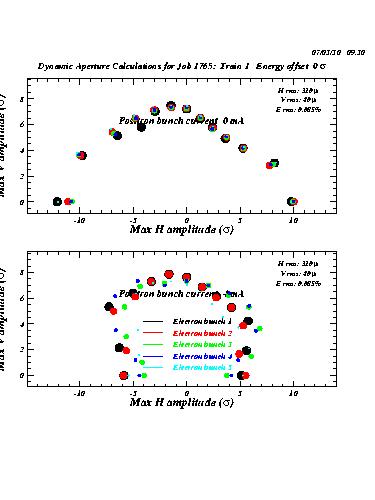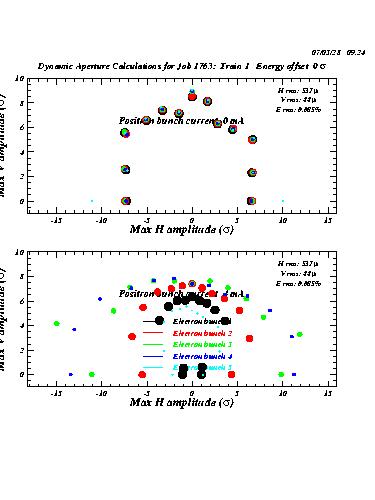Bunch-by-Bunch Analysis of CESR-c Optics
Lattice: fit_postop_20070116
30 March 2007
Present operational 3770 lattice, obtained by fitting phase and writing out lattice file in CESRV (thanks to mjf).
Operating bunch configuration (24 bunches): t1-8.b3-4,t2-9.b5 4 mA/bunch max.
These plots show the dynamic aperture for electrons in train 1 bunches 1-5 calculated via tracking. They compare the dynamic aperture calculations obtained by tracking through a lattice with no BBI distortion (0 mA e+ current) to that obtained by tracking through a lattice distorted by the BBI resulting from 4 mA/bunch in the positron beam.
Note that bunches 1, 2 and 5 are not filled in the present operating configuration. Our interest is restricted to the colliding bunches 3 and 4.
The plots on the left show the results obtained using BBI compensation method which consists of adjustng quad currents globally to keep the electron horizontal and vertical tunes constant as the positron bunch current increases. The tune values were chosen to be the same as the tunes obtained at 4 mA/bunch
using the PCBETING BBI compensation knobs (see job 1762), which are Qh/v = 0.546/0.665. The good dynamic aperture obtained during operation at 3 mA/bunch has been reduced at this higher positron current to less than 5 sigma for bunches 3 and 4 of train 1.
The plots on the right show the result obtained when the PCBETING BBI compensation knobs are applied with the coefficients given in file bbi_beta_00252ip_mgb2.com. These coefficients have been tuned to compensate both the IP and the parasitic crossings. The knob strengths are proportional to positron bunch current, with the zero point at a value for the bunch current of 2 mA/bunch.
These plots indicate that the PCBETING knobs can improve the dynamic aperture over the global tune correction from roughly 4 sigma to more than 10 sigma at this level of BBI distortion.


Creation date: 03/30/07.

